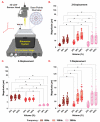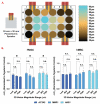Scalable and High-Throughput In Vitro Vibratory Platform for Vocal Fold Tissue Engineering Applications
- PMID: 37237672
- PMCID: PMC10215097
- DOI: 10.3390/bioengineering10050602
Scalable and High-Throughput In Vitro Vibratory Platform for Vocal Fold Tissue Engineering Applications
Abstract
The vocal folds (VFs) are constantly exposed to mechanical stimulation leading to changes in biomechanical properties, structure, and composition. The development of long-term strategies for VF treatment depends on the characterization of related cells, biomaterials, or engineered tissues in a controlled mechanical environment. Our aim was to design, develop, and characterize a scalable and high-throughput platform that mimics the mechanical microenvironment of the VFs in vitro. The platform consists of a 24-well plate fitted with a flexible membrane atop a waveguide equipped with piezoelectric speakers which allows for cells to be exposed to various phonatory stimuli. The displacements of the flexible membrane were characterized via Laser Doppler Vibrometry (LDV). Human VF fibroblasts and mesenchymal stem cells were seeded, exposed to various vibratory regimes, and the expression of pro-fibrotic and pro-inflammatory genes was analyzed. Compared to current bioreactor designs, the platform developed in this study can incorporate commercial assay formats ranging from 6- to 96-well plates which represents a significant improvement in scalability. This platform is modular and allows for tunable frequency regimes.
Keywords: bioreactor; displacement; fibroblasts; frequency; gene expression; mesenchymal stem cells; piezoelectric speaker; vibration; vocal fold.
Conflict of interest statement
The authors declare no conflict of interest.
Figures





Similar articles
-
Bioreactors for Vocal Fold Tissue Engineering.Tissue Eng Part B Rev. 2022 Feb;28(1):182-205. doi: 10.1089/ten.TEB.2020.0285. Epub 2021 Mar 17. Tissue Eng Part B Rev. 2022. PMID: 33446061 Free PMC article. Review.
-
Construction and characterization of a novel vocal fold bioreactor.J Vis Exp. 2014 Aug 1;(90):e51594. doi: 10.3791/51594. J Vis Exp. 2014. PMID: 25145349 Free PMC article.
-
Development of Vibrational Culture Model Mimicking Vocal Fold Tissues.Ann Biomed Eng. 2016 Oct;44(10):3136-3143. doi: 10.1007/s10439-016-1587-5. Epub 2016 Mar 7. Ann Biomed Eng. 2016. PMID: 26951463
-
A Flow Perfusion Bioreactor System for Vocal Fold Tissue Engineering Applications.Tissue Eng Part C Methods. 2016 Sep;22(9):823-38. doi: 10.1089/ten.tec.2016.0053. Epub 2016 Aug 15. Tissue Eng Part C Methods. 2016. PMID: 27537192 Free PMC article.
-
Tissue engineering-based therapeutic strategies for vocal fold repair and regeneration.Biomaterials. 2016 Nov;108:91-110. doi: 10.1016/j.biomaterials.2016.08.054. Epub 2016 Sep 2. Biomaterials. 2016. PMID: 27619243 Free PMC article. Review.
Cited by
-
Biophysical aspects of mechanotransduction in cells and their physiological/biological implications in vocal fold vibration: a narrative review.Front Cell Dev Biol. 2025 Jan 27;13:1501341. doi: 10.3389/fcell.2025.1501341. eCollection 2025. Front Cell Dev Biol. 2025. PMID: 39931244 Free PMC article. Review.
References
-
- Brunkan M.C. Preservice Music Teacher Voice Use, Vocal Health, and Voice Function Before and During Student Teaching. J. Music Teach. Educ. 2018;27:80–93. doi: 10.1177/1057083717741216. - DOI
-
- Jiang J., Bless D. Vocal Fold Stress in Voice Overuse and Abuse. Sig 3 Perspect. Voice Voice Disord. 2003;13:3–6. doi: 10.1044/vvd13.1.3-a. - DOI
Grants and funding
LinkOut - more resources
Full Text Sources

